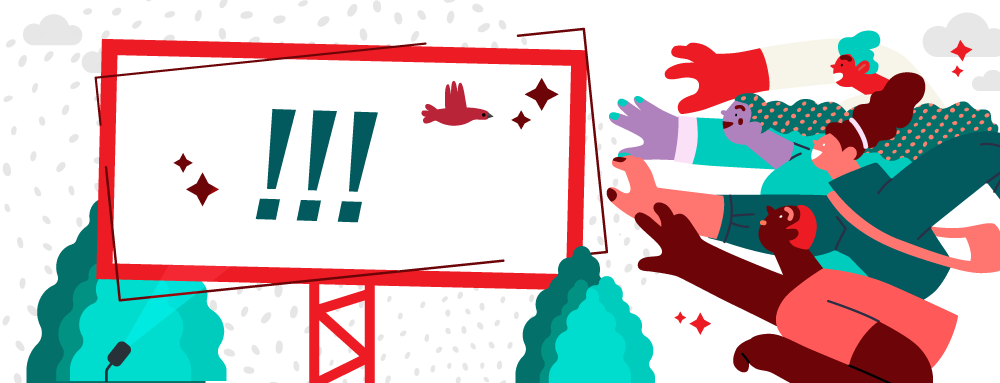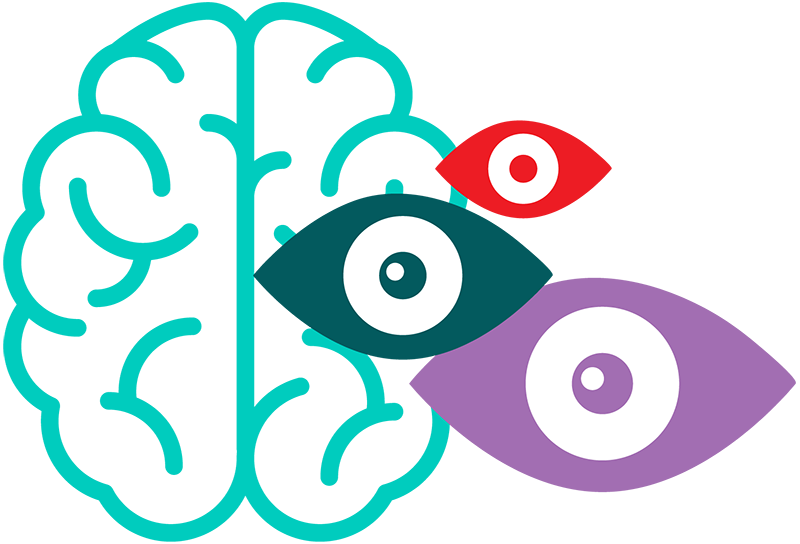
From McDonald’s golden arches to lawyers who promise to solve your issues with a single phone call, billboards, or ‘out-of-home’ (OOH) advertising has been a part of the marketing mix for over a century. With digital advertising comprising 65% of media spend, many articles may have you believe that billboard advertising is a relic of the past. But unlike a pop-up ad, billboards can’t be dismissed with a click. Should you use billboards to attempt to solve all your organizational needs? That’s a no from us, dawg. But when used strategically (in placement, purpose, and design), billboards can be a vital part of your integrated marketing strategy. Before our lesson on how your billboard design can best serve your brand, let’s look at the rise (and current outlook) of traditional advertising.
History of OOH Advertising
Although Johannes Gutenberg invented moveable type during the 15th century, mass production of posters (and thus advertisements) really took off with the perfection of the lithographic process in 1796. Prior to this modernization, most signage had to be hand-painted. While this style is resurfacing, anyone who’s paid a calligrapher or typographer knows it’s not necessarily time- or budget-friendly.
Due to the continued popularity of billboard advertising with merchants over the course of the 19th century, the Associated Bill Posters’s Association of the US and Canada was eventually created in 1891. Now known as the Outdoor Advertising Association of America, the group helped foster a better understanding of the utility of posters, provided assistance with coordinating services across the nation, and addressed any ethical concerns that arose (of which, as we know with early advertising efforts, there were PLENTY).
With the standardization of a billboard size in 1900 (followed by the increase in American roadway traffic), the advertising medium boomed. And while what’s been popular or permitted over the past century has changed, billboard advertising still takes a larger chunk of media spend than other print media.
Billboard Advertising Forecast
As we’re sure you’re painfully aware, 2020 was a difficult year for most industries. With quarantine restrictions, ad spend for OOH advertising took a huge hit – a 40% decrease to be exact. But this old workhorse isn’t dead yet. Forecasts predict a 9% increase in 2021 alone. And why is that? A few reasons:
According to the New York Times, the average person is bombarded with approximately 5,000 ads a day. With the previously given statistic about digital advertising, a majority of those are of the digital variety. If we don’t want to be bothered by an ad, we can simply close or skip it. Billboards, on the other hand, are less intrusive with their messaging. They don’t interrupt our YouTube videos or make it harder to get to the details of a recipe.
We’ve spoken previously in our blog about the importance of transparency and authenticity in reaching today’s consumers. The unobtrusive nature of billboards allows us to find them more trustworthy. According to a Nielson study, a larger percentage of Americans place more trust in traditional media (outdoor included) than online advertising.
Out-of-home advertising can provide a large-scale reach in a localized area. Perfect for brand awareness or reaching older audiences, billboards (when thoughtfully designed and used as part of the right marketing mix), can be highly effective at targeting your audience.
That last bullet point is the most important: to be effective, a billboard must be thoughtfully designed. And this is arguably more crucial with outdoor than with any other print or digital media because of how people interact with billboards. Before designing a billboard, understand that many of the traditional rules for print and digital design won’t always apply. To better understand why this is, we have to take a look into the psychology of how the human attention span works.
Psychology of Attention
If there’s one thing that is apparent about modern life, it’s that our attention is in a state of constant demand: the interstitial ad on your favorite news website; the televisions built into pumps at gas stations; the group chat that just won’t shut up but you can’t figure out how to leave. While we may or may not have an attention span comparable to a goldfish, the outrageous amount of stimuli we encounter every day makes it difficult to parse out the things that are worth remembering.
To understand why “less is more” when it comes to out-of-home advertising, let’s dissect the process of attention and its role in memory.
William James, known as the father of American psychology, described attention in the 1890’s best-seller “The Principles of Psychology,”

“Attention is the taking possession by the mind, in clear and vivid form, of one out of what seem several simultaneously possible objects or trains of thought.”
In other words, attention is what allows you to discern between unnecessary stimulus and critical information. As it’s been part of your operational system since birth, we don’t spend a lot of time analyzing this process. When we drive a car, we generally pay more attention to the distance between us and the next driver than we do the song on the radio (or that incoming text – the group message is at it again). However, attention is one of the most critical players in almost every realm of our lives. Education, working, commuting, interpersonal relationships, and of course, our favorite, marketing and advertising, all tap into our attention processes.
Three Forms of Attention
To get the most out of this article, which really IS about OOH advertising aesthetics, it’s important to understand the three types of attention and how they help us form memories. In short, attention allows us to take in information; memory allows us to process it.
Selective Attention: As attention is a finite resource, we need to be able to pick and choose what stimuli gets our attention. We do this by unconsciously tuning out unnecessary elements in our environment. Through this filtering, our working memory chooses what gets to be a part of our “cognitive load.” Basically, the amount of mental effort our brain will allow us to utilize at any given time.
Focused Attention: Best described as a rapid, automatic response to external stimuli. An example of focused attention would be noticing a bolt of lightning or the brake lights of the car ahead of you on the highway.
Limited or Divided Attention: This is the form of attention that gets the most grief – and the one we can most identify with in the current age. Limited attention involves shifting focus between stimuli rapidly, or “multitasking,” (in quotation marks, as the human brain really is incapable of focusing on multiple demands at once).
Design for Attention
How do we grab the attention of a viewer whose attention is already divided because of driving? We have to lighten the cognitive load of the consumer. Simple, right? Perhaps not, but it is definitely achievable.
We’ve previously written an entire manifesto, ahem, blog, about why Marketing Design is Not Subjective. In the same vein, this blog is really about out-of-home advertising – namely the billboard. And why “keep it simple, stupid” is the philosophy we should all be subscribing to. We must make very thoughtful messaging and design choices when designing for this medium.

check out our blog
Marketing Design
is Not Subjective
We should not make decisions based on our own personal design sensibilities, but instead on peoples’ innate psychological processes.
A generally accepted truth of billboard advertising is that you have about 2-5 seconds to engage your viewer. The less content you give them to focus on, and the more impactful that content is, the higher the chance their brain will choose to retain it.
Billboard Design Considerations
Here are some general tips and things to consider when developing your billboard.
Only keep the important stuff/Cut out the fluff.
Maximizing your space doesn’t mean you have to include every piece of content just because the space is there. A billboard’s physical space allows for many things, but NOT your three-paragraph company mission statement. If your board is filled to the brim with information, people won’t know where to focus or what to retain. In the limited space and time in which the billboard is viewed, eliminating distracting elements is crucial for success.
“Any element that isn’t helping the user achieve their goal is working against them because they must process it and store it in working memory, alongside the things that will help them. Avoiding excessive colors, imagery, design flourishes, or layouts that don’t add value is crucial.“ — Senior Product Designer at Sonic Boom Jon Yablonski
Tips:
- Be judicious with your use of taglines and mission statement text. The most effective messaging is short, bold, and legible.
- Only use a web address if the URL is short and easy to remember. And cut the “www.” People don’t need it anymore to understand that it’s a web address.
- Telephone numbers are no longer crucial to include. (And who is going to remember a long string of numbers in the 2-5 seconds they have with your board?). If the viewer can google you, they can easily find your number.
- If your physical address is long, use landmarks to provide directions. Example: 2 miles; Exit XX.
Ask for help.
Zoom out on your design (this will help simulate what a driver will see) and ask someone who is not familiar with the content to look at it. Ask them what they notice first; see if they are able to easily understand the message you are trying to send. If they struggle to make out what they are seeing, go back to the drawing board.
Tip: Visuals like photography and illustration are great, but be careful not to clutter the limited real estate on your board. One large photograph is preferable to multiple smaller ones.
Legibility is king.
Make sure the information you want your audience to retain is visible, and legible, from a distance. Use the zoom-out trick to test your design. Choose fonts that retain their legibility at multiple point sizes, and increase the size of your most crucial information. Remember, you aren’t designing an ad for a magazine; it’s OK to sacrifice generous margin space to increase the visibility of your most important content.
Consider your environment.
When making design choices, visualize how your design will look once it’s been physically placed. Is your board utilizing a blue color that may cause it to disappear against the blue of the sky? How will your information look after the sun goes down? Speaking of the sun, it has a nasty habit of bleaching out colors over time. Use color combinations that will still have good contrast even if the colors have been washed out. Additionally, consider avoiding color combinations that are known to cause problems for people with color vision deficiency, a.k.a. colorblindness.
Design based on your overall goal.
If your board has a CTA or is primarily for directional purposes, maximize the visibility of that content and scale back on any excess that may compete for attention. If your goal is brand awareness, do something memorable with imagery and your message, and minimize contact information. As long as people can clearly see your name, they can find you on google and social media.
The More you Know
Now that you’re versed in the history, psychology, and design of effective billboard advertising, the sky’s the limit (pun TOTALLY intended). Utilize these tips to maximize your billboard’s impact – or – connect with Red Thread and let us help!